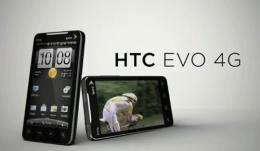Extra-large smart-phone screens don't always give best results

You've seen super-sized houses, super-sized cars, super-sized televisions and, of course, super-sized meals. Now come super-sized smart phones.
Apple's iPhone made the 3.5-inch-or-so touch screen standard fare for new smart phones soon after it debuted in 2007. Now, hoping to differentiate themselves from the pack -- and maybe even lure some would-be iPhone buyers -- some phone manufacturers are starting to debut models with 4.3-inch displays.
I've been testing out two of these jumbo models, both of which use Google's Android operating system: HTC's Evo 4G from Sprint and Motorola's upcoming Droid X, which will be offered by Verizon starting July 15. In general, I like them, as I have most recent Android phones.
But bigger isn't always better.
Because of the bigger display size, text on the screen -- in a Web page, say, or an e-mail message -- is noticeably larger than it is on an iPhone or HTC's Droid Incredible, which has a standard-sized screen. That's a good thing for those of us with weak eyesight or who are tired of squinting at too-small text.
However, the big screens are being touted as much for video as for simply displaying Web pages or e-mail. Both phones include video services or apps that allow users to watch television or movies on them.
But that's where the bigger screens actually come up short. While both phones' displays are bigger than those of other touch-screen smart phones, they have the same number of pixels as those other devices, or even fewer if compared to the new iPhone 4.
That means video and movies on the big-screen phones are noticeably less sharp and more pixilated than they are on the screens of smaller rivals, particularly the iPhone 4. And while you can record high-definition video using the 8-megapixel cameras built into both devices, you can't watch those videos in their native resolution on the phones.
Another consequence of the big screens is that the phones are significantly larger than other smart phones in both their physical dimensions and weight. They'll still fit in a shirt pocket, but I found that holding them in my hand or up to my ear felt awkward.
The two new phones have more in common than just their screens. They both run Android version 2.1, which means that neither one yet supports the new version of Adobe's Flash software that's been designed for mobile phones. The new Flash requires the just-released Android 2.2 operating system. Motorola says it plans to provide Flash and the latest version of Android to Droid X users in late summer; Sprint says it will provide the update "in the near future."
Despite their common features and software, the phones do have some distinguishing features. One of the Evo 4G's is mentioned in its name: the phone is one of the first to be able to connect to the Internet using Sprint's new "4G" data network.
Unfortunately, Sprint's 4G coverage currently is limited to 36 cities or metro areas scattered around 14 states, none closer than Las Vegas or Salem, Ore., so I wasn't able to test it out. But the company plans to bring its 4G network to the San Francisco Bay Area later this year.
Another thing that sets the Evo 4G apart from the Droid X is a forward-facing camera, much like the one on the iPhone 4. But using the Evo's camera to make a video call is nowhere near as easy as it is on the iPhone 4, because the Evo doesn't have a program like the iPhone's FaceTime, which allows you to switch a regular phone call to a video one instantly. Instead, you have to use third-party video-chat software -- and hope that the person you are trying to reach has the same software installed.
These limitations aside, I found a number of things I liked about the Evo 4G. The phone has the latest version of HTC's Sense user interface, which allows you to check your calendar or turn off the phone's Bluetooth antenna directly on one of the phone's home screens. Another thing to like about the Evo 4G is Sprint's subscription plans, which are among the best deals in the industry.
But Sprint's coverage can be spotty, both in the Bay Area and across the nation.
The Droid X has the advantage of superior coverage, which has long been Verizon's calling card. It also has a better screen. Although it's the same size and resolution as the screen on the Evo 4G, it displayed videos in warmer, more natural tones.
Similarly, pictures taken indoors with the Droid X's camera were much more natural in color than those taken with the Evo, even if viewed on a PC rather than on the phone's screen. And the Droid X had a more powerful flash than the Evo's, which seemed a bit underpowered. I could see shadows in the edges of a picture taken with the Evo's flash, but there were no such shadows on a Droid X picture.
Finally, I liked that the Droid X uses physical buttons in place of the touch-sensitive ones on the front of the Evo 4G. With the Evo, I frequently pressed the search or other buttons inadvertently while trying to read a Web page or watch a video.
But for most consumers, the question of which of these two devices is better is likely to be overshadowed by the issue of whether their jumbo screens make either of them worth getting over other smart phones. For me, anyway, they're not. I prefer the smaller, lighter HTC Droid Incredible and the iPhone 4. They both feel better in my hand and their screens look better to my eyes.
You may see things differently. HTC and Motorola are sure hoping you do.
(c) 2010, San Jose Mercury News (San Jose, Calif.).
Distributed by McClatchy-Tribune Information Services.





















